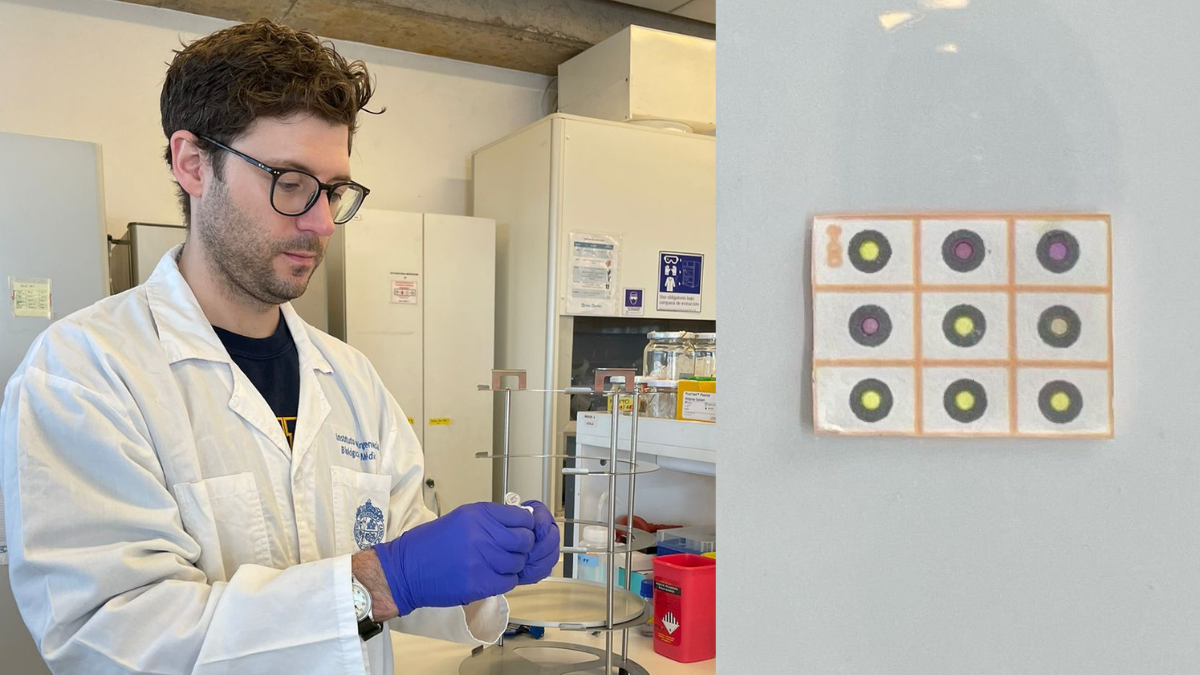Justin Vigar is developing paper-based diagnostics like the paper chip shown on the right. Each dot represents a different test. Yellow dots are negative and purple dots are positive.
October 12, 2023
By Betty Zou
For some people, synthetic biology may conjure up images of biohackers working away in DIY labs in their garage or basement. But for University of Toronto graduate student Justin Vigar, the field holds immense promise to improve the health and lives of people around the world.
Synthetic biology is a relatively new field of research that applies engineering principles to recreate fully functional biological systems. A recipient of an Emerging and Pandemic Infections Consortium Doctoral Award, Vigar is using synthetic biology to develop rapid, low-cost diagnostic tools to combat infectious diseases.
The gold standard for diagnosing many infectious diseases today is a technique called real-time reverse transcription-quantitative PCR (RT-qPCR), which is both sensitive and specific enough to detect small amounts of a particular microbe in a patient sample. However, the process is complex, requires expensive equipment and materials, and must be carried out by highly trained personnel.
“We talk a lot about South America and other countries in the global south but in most areas in Canada, including rural Alberta where I grew up, there’s no access to RT-qPCR,” said Vigar, a fourth year PhD student working with Keith Pardee, an associate professor in the Leslie Dan Faculty of Pharmacy.
This gap was especially apparent during the COVID-19 pandemic when many low- and middle-income countries struggled to track the spread of SARS-CoV-2 within their borders because they did not have the infrastructure, expertise and resources to conduct timely RT-qPCR testing for their populations. Rapid antigen tests helped to make testing more accessible but they aren’t as sensitive and cannot be easily scaled up to process hundreds of samples at a time.
“We wanted to fill that gap by building really accessible tools that could do rapid screening for COVID-19 and other infections, something that would be a midway between a rapid antigen test and RT-qPCR,” said Vigar.
To that end, he and his lab mates are creating a customizable, paper-based platform that uses pocket-sized slips of paper with genetic circuits embedded onto them. The circuitry is built by freeze drying proteins and other molecular components, which function as amplifiers and sensors, directly onto the paper. Patient samples are minimally processed to extract the genetic material and applied directly to the paper. If the patient sample contains genetic materials from the pathogen of interest, it will trigger the circuitry to switch on and produce a colour change on the paper, which can be easily seen by the naked eye.
Pardee’s team has already proven the effectiveness of their paper-based diagnostic in enhancing disease surveillance during Brazil’s 2015-16 Zika virus outbreak and more recently, the COVID-19 pandemic. Now Vigar is working with collaborators in other Latin American countries and India to expand its use to monitor other infectious diseases like dengue fever and leishmaniasis, which is caused by the Leishmania parasite.
“We have the system working very well in Toronto and a couple of our collaborating countries but the challenge now is sourcing the materials to embed onto the paper and scaling up in other countries,” he said.
While it’s easy for Vigar to get the components and build the paper devices in Toronto and ship them to collaborators around the world, his ultimate goal is to empower them to manufacture and distribute the tools locally.
“We need to work with researchers in other countries to build a network that will give them access to these reagents and materials so they aren’t relying on us to ship it to them. Then they’ll be able to build their own pipelines to detect the pathogens and diseases that they’re interested in.”
He was in Chile for two weeks this summer to help researchers there to test the reproducibility of their locally made paper tests. Pardee’s lab also hosted two visiting students from Universidad de Los Andes in Columbia recently to learn the process for building the low-cost devices.
Beyond monitoring infectious diseases in humans, Vigar envisions the paper-based platforms being used to answer other important questions related to human and planetary health — for example, tracking the spread of an agricultural pest or the movements of an endangered species.
Vigar’s passion for synthetic biology and ensuring equitable access to new biotechnologies extends beyond the lab. He is an active delegate to the United Nations Convention on Biodiversity (UNCBD), which includes two international agreements on biosafety and profit sharing related to synthetic biology and biotechnology. As an attendee at the UNCBD Conference of the Parties (COP) in Sharm El-Sheikh, Egypt in 2018 and in Montreal in 2022, he educated attendees about synthetic biology and shared his perspectives on how low-cost diagnostics can improve the lives of people around the world.
“These technologies are so powerful but they’re limited in where and how they’re used. We want to make it more accessible and if we work collaboratively toward that goal, it’s going to benefit so many more people.”


